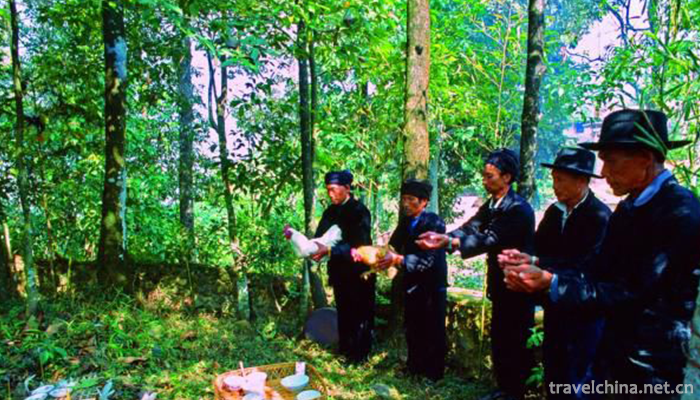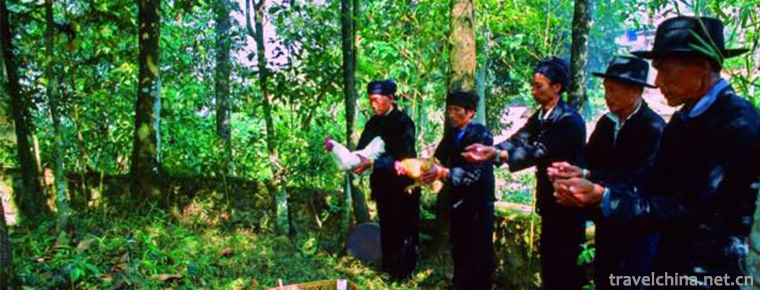Sacrifice forest
Sacrifice forest
Sacrifice to the gods of villages, as well as "Amaron" and "Pumatu" and other names, is a traditional festival of the Hani people, which takes villages as units and integrates religious and entertainment activities.
Main activities
The Hani people living in Ailao Mountains, Yunnan Province, no matter which branch they belong to, have an "Amatotu" festival, a festival to worship the gods of villages. Among them, the most important is the "Amatotu" of the Hani people in Pugui Village, Yinyuan Town, Yuanjiang County. Every year, they hold a three-day festival to worship the village shrines.
Two groups of male villagers, driving animals, carrying pots, bowls and ladles, were led by "Mobi" (religious leaders) to the water source Longtan and the mountain, two or three kilometers away from the village, for sacrificial activities. In the activities of offering sacrifices to mountain gods and dragon pools, people must take off their shoes, barefoot or wear socks before they can enter the sacrificial site. The next day, we will go to the deep mountain covered by forest - the source of the canal for sacrificial activities, and the sacrificial ditch can be entered by wearing shoes. In the activities of sacrificing mountain gods, sacrificing dragon pools and sacrificing water ditches, all the animals, big or small, are slaughtered and cooked on the spot. Boiled and then sacrificed to the gods - the tree of gods, and then shared, symbolizing the protection of the gods.
The sacrifice to the village god forest is the most lively, solemn and mysterious sacrificial activity in the past three days. In the early morning, when the morning glow was full and the weather was very good, the villagers rushed the cattle to the village immediately above the sacrificial platform of the village gods. Men are busy according to their division of labor, morning glory, water carrying, pot lifting, bowl taking, wine lifting, firewood delivering, fire making, water boiling... Smoke filled the forest of Zhai Shenlin, and people came and went on the sacrificial platform in a tense and orderly manner. Women are not allowed to participate in all sacrificial activities. There are also special rules for sacrificing the village gods. When slaughtering animals and sacrificing the God trees, no foreigners are allowed to take part in the sacrifice, let alone photograph by anyone.
After the completion of the main sacrificial activities every day, the villagers gathered in the village's only open space and danced "Canla and Twist" together happily and tirelessly. Drum and gong sounds are simple and pure, thick and distant, and the "Canla and Twist" dance is concise, lively and relaxed, with a jump lasting three or four hours.
Inheritance significance
"Sacrifice Village Shenlin" is a traditional folk festival in the Hani minority areas. Through annual sacrificial activities, we pray for a bumper harvest of Hani terrace agriculture; bless the villagers with prosperity, good luck, tranquility and natural communication; inherit Hani's traditional production and life, virtue, singing and dancing knowledge and skills; praise Hani's national spiritual wisdom, good morality; publicize and display the local Hani people's culture. The inheritance genealogy of Shenlin is very complex. The inheritors require strict conditions. They must have high moral values, both husband and wife, children, family harmony and no violation of discipline. The representative inheritor is Lu Literature, a villager of Dayutang Village, Tuguozhai Village Committee, Xinjie Town, Yuanyang County. His family has been the priest who presided over the sacrificial forest of the village since his great-grandfather (Hani: Migu).
Protection status
The sacrificial village of Shenlin is a kind of traditional skill and folk custom which was approved by the State Council in 2011 and listed in the third batch of national intangible cultural heritage list.


-
1.Lake Manasarovar
Ma Pang yongcuo is 35 kilometers east of the town of Pu Lan county
Time 2018-10-12 -
2.Yin and yang
There are three characteristics of yin yang philosophy: unity, opposition and interaction. In thinking, it is an inseparable node of arithmetic and divination.
Time 2018-11-13 -
3.Danxia Chishui
Danxia National Geopark in Chishui City, Guizhou Province, is located in the southern edge of Sichuan Basin, close to the northern foot of Daloushan Mountain in northern Guizhou Province and the weste
Time 2019-01-05 -
4.Shimen Xianhu Scenic Area
Shimen Xianhu Scenic Area is the first national 3A-level tourist scenic spot in Rongan County, located in Liuzhou, Guangxi. It has high Gorges out of Pinghu Lake
Time 2019-02-08 -
5.Songxian Tianchishan National Forest Park
The Tianchishan National Forest Park in Songxian County, Luoyang City, is located in Xionger Mountains, northwest of Songxian County, Luoyang City, with a total area of 1716 hectares and a forest cove
Time 2019-02-13 -
6.Xujiahuiyuan Scenic Area
Xujiahuiyuan Scenic Spot is located in Xujiahui, Shanghai Metropolitan Tourism Center Circle. It starts from Wanping South Road, Tianping Road and Huashan Road in the east
Time 2019-02-26 -
7.Architectural coloured drawing
Building painting is a kind of image art, which occupies an important position and unique function in building decoration. It has vivid image, abundant content, observability and practicability
Time 2019-05-05 -
8.Laoshan Folk Stories
Laoshan folk tales, commonly known as Lagua, are oral literature created by the local people of Laoshan Mountain in Shandong Province for thousands of years. There were few written records before libe
Time 2019-05-11 -
9.Lead tin carving
Lead and tin carving, a local traditional skill in Jingzhou City, Hubei Province, is one of the national intangible cultural heritage.
Time 2019-06-10 -
10.Skills of Dry Lacquer and Ramie in Tiantai Mountains
As early as the Eastern Jin Dynasty, dry lacquer and ramie had been used in Tiantai folk. Through the continuous efforts of the substitute craftsmen, their skills gradually matured. In the mid-Tang Dy
Time 2019-06-21 -
11.Coconut carving
Coconut sculpture is made of coconut shell, coconut palm and coconut wood as raw materials, and is carved into various practical products and plastic arts by hand. Coconut sculpture is one of the spec
Time 2019-07-11 -
12.Zhongshan Salt Water Song
Salt water song is a form of expression of Guangdong local folk songs, which is mainly spread among farmers and fishermen in the coastal and river network areas of Zhongshan, Panyu, Zhuhai and South C
Time 2019-08-03